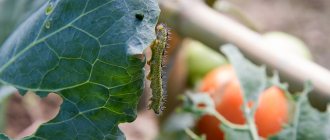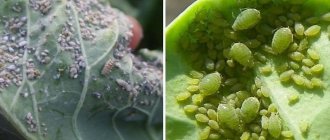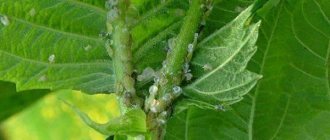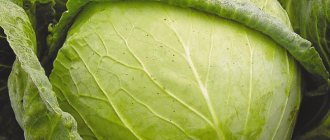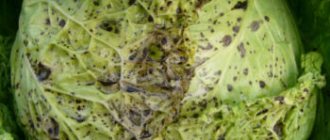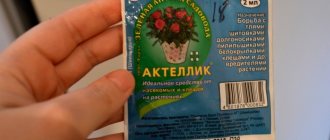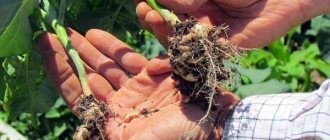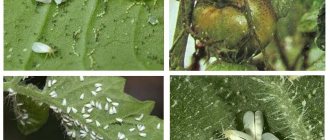Cabbage is often infested by various microorganisms, one of which is cruciferous flea beetles - tiny jumping bugs that feed on the juice of the garden vegetable. They are especially active in dry and hot weather, so to protect the crop it is necessary to increase air humidity, including by sprinkling. But how to recognize these microscopic pests in time and quickly get rid of them, we’ll figure it out further.
How to recognize a flea?
If small dots and holes appear on the cabbage leaf plate, suspicions may arise that the vegetable is affected by cruciferous flea beetles. However, before selecting chemicals or traditional medicine, it is necessary to accurately determine the type of pest, otherwise it will not be possible to get rid of them, but the plant may suffer.
Cruciferous flea beetles can be recognized by the following characteristics:
- these are small bugs, the size of which often does not exceed 3 mm;
- the body of insects is short, sometimes slightly elongated;
- the upper side of the body is smooth, not covered with hairs;
- the length of the antennae is usually no more than half the body;
- insects are distinguished by their jumping ability due to their strong hind legs.
These flea beetles lay small, light-colored eggs, which hatch into microscopic, thin, yellowish larvae with three pairs of legs. They develop in soil and feed on plant roots, mainly weeds. The larvae transform into adults within 2-4 weeks.
As they develop, the color of the integument may change. In general, you can accurately determine the type of cruciferous flea beetle by color. The most common types are:
- Wavy . Distributed in the Far East, Siberia, the Middle Urals and in the north of the European part of Russia. It can be distinguished from other representatives by the yellow notched stripes on the elytra. The larvae feed on the lateral roots of cruciferous plants, and the beetles eat the leaves, leaving only the veins intact.
- Notched . The variety has chosen the south of Yakutia, the Amur region and Primorye. It also has yellow stripes on the elytra, but on the outside they have a deep semicircular cutout.
- Light-footed . Found in large numbers in the southern regions of the forest zone. This is a larger representative of the leaf beetle family, the size of which can reach 3.5 mm. The head and the upper half ring of the first chest segment are black with a greenish or bluish tint. The shins and paws are yellow.
- Southern or black . The most harmful insect, which is distributed throughout the Russian Federation, with the exception of the Far North. The insect is painted black, but sometimes a metallic tint is noticeable. On the elytra you can see points located in regular rows.
- Blue . Distributed throughout Russia. It can be distinguished from other types of flea beetles by its blue or green color with a silky tint.
The closer to the south, the more types of flea beetles gardeners encounter in their plots.
Interestingly, the cruciferous flea beetle is so named because it prefers to feed on plants of the cruciferous family. Vegetable crops she eats with appetite:
- different types of cabbage (white cabbage, cauliflower, broccoli and others);
- turnip, daikon, radish;
- turnips, rutabaga;
- leaf mustard;
- horseradish;
- radish;
- spinach;
- arugula.
Among the wild plants, flea beetles choose shepherd's purse, common colza, field grass, and wild radish, and among the flower plants, roses, chrysanthemums, alyssum, matthiola, and gillyflowers.
Appearance and description
Cruciferous flea beetles vary in color depending on the species and region in which they live. Usually these are small black bugs up to 3 mm long. They can be striped, green, blue with a metallic sheen or matte finish. Almost all species have a convex back and powerful hind legs. A distinctive feature of the insect is its jumping ability. The small bug easily jumps several meters, unhindered covering vast distances, including between areas.
There are several known species of cruciferous flea beetle that live throughout the entire territory of the former USSR, with the exception of the regions of the Far North. The pest overwinters in the upper layers of the soil, under leaves, and sometimes in cracks of wooden structures.
When and how do flea beetles attack cabbage?
The beetles overwinter in the soil or in greenhouse structures. In addition, in cold weather they can hide in piles of last year's fallen leaves. In the spring, as soon as the air temperature reaches +15°C, they wake up and eat wild cruciferous weeds. As soon as seedlings are planted on the site or the first shoots of crops of the same family appear, flea beetles immediately move to them.
Pests are most active during the hottest part of the day.
You can determine that a flea has appeared on cabbage by changes in the appearance of the vegetable crop:
- small holes form on the leaf plate as insects eat away its top layer;
- cabbage leaves become riddled, and the area around the holes turns yellow (this sign is often observed with a large pest infestation);
- young plants weaken, lose turgor and dry out even with abundant watering, since the larvae develop on the roots and often damage the root collar of the seedlings.
Fleas are clearly visible to the naked eye. As soon as you touch the bush, they begin to jump out in different directions.
Methods for controlling parasites on Chinese cabbage
Having planted cabbage on your plot, hurry up and treat it against pests and diseases. You can carry out prevention using traditional methods or give preference to other methods using chemical reagents.
Traditional methods
Using these methods, you get rid of various insects that can harm the plantings. Let's consider several ways that can help solve the problem:
- Experienced summer residents catch slugs by creating traps. They place slate and boards on the site and water the soil under these shelters. In the heat, the pests will gather in the trap; you just need to destroy the shelter and collect them. Slugs also have difficulty overcoming obstacles made of broken bricks or rubble, and they also cannot tolerate salt. Simply sprinkle salt on the slug and it will die.
- Wormwood repels insects well; its branches are placed near the plantings in order to scare away pests in this way. Not a bad method, but you will have to regularly renew the grass.
- Chop 10 heads of garlic, pour 5 liters of water over them, leave for 4 hours, then boil for 20-25 minutes, cool, strain and use the broth for spraying.
- A mixture of wood ash and tobacco dust will protect the crop from aphids and other pests.
Insects successfully lay eggs on the lower leaves of the plant. This fact should be taken into account when carrying out processing.
Chemical and biological drugs
When using such solutions to treat crops, do not forget that the procedures must be carried out in a timely manner, since otherwise toxins will remain in the plant and can harm human health.
The following drugs are the most popular among gardeners:
- Rescuer;
- Aktara;
- Spark.
Mechanical processing method
It involves maintaining optimal conditions for plant growth. But even if the crop is processed in a timely manner, watered, and loosened the soil, this will not be able to rid it of slugs and caterpillars.
For this reason, if they appear on the site, collect insects, most often this is done manually, as a result of which it is possible to preserve the vegetable. For caterpillars that have already grown and begun to devour cabbage, as well as snails and slugs, this method is effective. But provided that the culture is biologically healthy.
See also
Description of cabbage variety Gloria F1 and features of growing the hybrid
Read
How dangerous are fleas?
These bugs are serious agricultural pests that can cause significant damage to gardeners in a few days. In case of a massive invasion, one plant can be inhabited by 50 to 200 voracious individuals, which in a matter of days can destroy all cabbage seedlings, radish shoots, turnips or turnips.
It is worth considering that flea beetles reproduce very quickly in dry and hot weather - up to three generations of insects appear in one growing season. So that the crop does not dry out and die in a few days from a large infestation of fleas, you will need to immediately begin to fight them.
How to treat crops in advance to protect them?
To reduce the risk of attack by insect pests and try to make do with folk remedies, vegetable growers take the following preventive measures:
- choose a site, taking into account the rules of crop rotation;
- observe the planting time for Chinese cabbage;
- use mesh shelters from butterflies;
- make baits and traps for slugs and mole crickets;
- Phytoncide plants are planted next to the “Beijing”.
In addition, there are folk remedies that can repel most harmful insects - these are decoctions and infusions from plants containing phytoncides and insecticides, as well as preparations based on household and pharmaceutical products.
- To protect Chinese cabbage from pests, plants and row spaces are dusted with a mixture of ash and red pepper.
- You can get rid of flying insects by pre-treating Chinese cabbage with an infusion of mustard or tobacco dust.
- Small midges can be repelled with decoctions of wormwood and onion peels.
Important!
But if pests do attack the cabbage beds, the gardener must identify the insect by its appearance and use folk or special chemicals to combat it.
Agrotechnical measures against flea beetles
A number of agrotechnical measures will help prevent the appearance and reproduction of microscopic insects. Each of them requires separate consideration.
Compliance with planting deadlines
Planting cabbage seedlings before and after the main stages of insect development helps to avoid massive leaf damage. The best option is to sow early varieties in April and late varieties in July. In the first case, by the time the insects appear, the cabbage has time to take root and develop, and its leaves become rough, so the insects cannot gnaw through them and lose interest in them. In the second case, the bugs do not have time to cause much damage to the plants.
Using covering material
In areas with hot summers, the simplest and most effective way is to cover the seedlings with a special covering material immediately after planting them in a permanent place in open ground. For these purposes, a special mesh or spunbond, lutrasil and non-woven fiber are used.
Planting phytoncidal plants around the perimeter of the site
Crops rich in essential oils and with a strong odor will help repel fleas from cabbage. These are:
- marigold;
- calendula;
- fennel;
- dill;
- nasturtium;
- caraway;
- coriander.
They should be planted around the perimeter of the cabbage beds.
Increasing air humidity (watering)
These insects prefer dry air, so creating more humid conditions can curb their reproduction and numbers. To do this, it is enough to water the cabbage more often by sprinkling.
Weeding
If you remove weeds in a timely manner, the conditions for fleas to live and reproduce will not be the most favorable. In this regard, in the fall, after harvesting vegetables, it is worth thoroughly clearing the area of plant debris.
What to do if there are fleas on cabbage
If there have already been cases of fleas appearing on a given piece of land, then it is important to prevent the appearance of fleas. They do this by regularly killing weeds. In the fall, shallow digging of the soil is carried out and the layers of earth are turned over. To destroy fleas, folk remedies, chemicals and bioinsecticides that are harmless to humans are used.
Flea beetles cannot tolerate high soil moisture, so regular watering will stop the growth of insect numbers. At the same time, insect repellent infusions, decoctions or plant juices are added to the water. The location of the beds for cabbage and cruciferous plants is chosen in the lowlands. It has been noticed that contaminated leaves are damaged by flea beetles to a lesser extent than tender, clean leaves.
Folk remedies for removing fleas
Folk remedies are most effective at the very beginning of the pest growing season, as they help prevent a massive infestation of fleas. They can also be used in cases where pest numbers are low.
How to fight fleas on cabbage using anti-flea shampoo, learn from the video:
Ash dusting
Experienced vegetable growers have noticed that flea beetles do not settle in areas dusted with wood ash. It is laid out in each hole when planting cabbage seedlings in a permanent place, and then it is also sprinkled between rows after planting is completed.
To prevent the leaves from being to the taste of the bugs, they are treated:
- tobacco dust;
- a mixture of stove ash and slaked lime (fluff).
Spraying with infusions and solutions
To get rid of cruciferous flea beetles, cabbage can be sprayed with various means. The following recipes have worked well:
- Tomato-garlic infusion . 250 g of fresh tomato tops are crushed, and 10 garlic heads are passed through a meat grinder or garlic press. Plant components are poured into 10 liters of warm water and infused throughout the day. Next, the infusion is filtered and 50 ml of liquid soap is dissolved in it for better adhesion of the liquid to the leaf plate.
- Dandelion infusion . 500 g of fresh dandelion leaves and flowers are crushed and poured into 10 liters of water. Leave for 3 days, then filter and add 50 ml of liquid soap.
- Ash-soap solution . 1 g of crushed ash is poured into 3 liters of boiling water and left to infuse for 2 days. Then add 1/4 of a bar of soap to this mixture - laundry, green potassium or tar.
- Infusion of chicken manure . Chicken manure is diluted in water in a ratio of 1:20. Leave the mixture to ferment in the open air and use it for its intended purpose.
- Tobacco infusion . It is prepared from 200 g of tobacco and 10 liters of water with the addition of a small amount of soap.
- Wormwood infusion . 1 kg of fresh plant material is crushed and 10 liters of boiling water is poured. Infuse it for one day, covering the container with a lid.
Freshly picked twigs of wormwood or tansy can be placed between the rows of cabbage beds, as they contain a lot of essential oils, have a pungent odor and have a repellent effect.
Video about simple and reliable means of combating cruciferous flea beetles:
Using adhesive tape
This method helps reduce the number of pests. To do this, a layer of some sticky compound - resin, tar or natural honey - is applied to thick cardboard or plywood on both sides.
Then, waving this device, they walk several times along the rows. Disturbed fleas begin to jump and stick to the sticky layer. After the procedure, the cardboard with insects stuck to it is burned.
Using motor oil
Some vegetable growers, who also happen to be car owners, have noticed that flea beetles are attracted to the smell of used motor oil. So, in order to remove some of the pests from the cabbage, you can place rags well soaked in oil on the garden bed at a distance of 3-4 m.
Chemical control agents
Methods of controlling flea beetles on cabbage depend on the degree of damage to the garden bed. If there are a lot of pests, it is better to immediately turn to chemicals:
- Pochin - used on seedlings and immediately after planting in the garden;
- Alpha-super - emulsion concentrate, enteric-contact insecticide, resistant to washing off, destroys cruciferous flea beetles at all stages, protective effect - up to 3 weeks, waiting period on cabbage (before harvesting) - 1 month;
- PSK - for spraying, use according to the instructions, you can add 100 ml of the drug to a bucket of water, wet rags, spread between the rows of cabbage;
- Lightning Extra;
- Aktara;
- Fufanon-Nova;
- Alatar;
- Carbocin.
Important! If gardeners, when choosing products to treat cabbage against pests, decide to use intestinal preparations, it is recommended to spray in the early morning. At this time, the leaves actively breathe and absorb the insecticide better, therefore, the result will be quick.
How to fight fleas with special preparations?
If the flea beetle population is very large and there is a risk of destruction of the entire crop, then chemical or biological preparations are used.
Biological insecticides
They have a low level of toxicity, so they do not cause any harm to humans or beneficial insects. One of these insecticides is Actofit, which is used taking into account the following recommendations:
- the solution is prepared from 4 ml of the drug and 10 liters of water and is used immediately by spraying plants with it, since after a few hours its effectiveness decreases;
- treatment is carried out at the first signs of the appearance of fleas in dry, windless weather and at an air temperature of +16...+28°C, since at lower temperatures its properties also deteriorate;
- re-treatment is carried out after 2-3 weeks.
12-18 hours after treating cabbage with Actofit, insects stop moving and die within 2-3 days.
Chemicals
They help quickly destroy insects, but they are harmful to all living beings - humans, animals, birds, pollinating insects. When using these drugs, it is necessary to remember personal protection. The treatment is carried out in dry, windless weather, preferably in the evening, when fleas become less active.
Here are the most effective drugs:
- Aktara. This is an enteric-contact insecticide, the main substance of which is thiamethoxam. The product is diluted in warm water (25°C) at the rate of 3 g of substance per 10 liters of water. The solution is used immediately for its intended purpose - the leaves are sprayed with it or it is poured under the bush. The remaining product is not stored, but disposed of. The drug is not washed off with water. It begins to act 30 minutes after treatment and retains its properties for 3-5 weeks. To get rid of all fleas, the solution should not be used 1-2 hours before precipitation.
Aktara does not accumulate in fruits and plants, and is not addictive to parasites; however, it is toxic to pollinating insects, so it is not used during flowering.
- Aktellik . A contact-intestinal insecticide that acts on the digestive and nervous systems of pests. To spray cabbage, take 2 ml of the drug and dissolve it in 2 liters of water. This volume is enough to process 20 square meters. m beds. When using this drug, the following nuances must be taken into account: plants are not treated with a weakly concentrated solution, since it causes the death of only weak individuals, and strong adults become resistant to the product;
- Cabbage cannot be processed after dew, rain or 2 hours before precipitation:
- It is not recommended to spray the prepared solution in strong winds;
- insects get used to this drug, so it is prohibited to use it for several years in a row.
Actellik is a highly toxic product not only for pollinating insects (bees and wasps), but also for fish, therefore it is prohibited to use it near bodies of water.
The duration of the protective effect is 15 days. Treatment is carried out in dry weather in the evening. The maximum number of sprayings is 2 times per season. A solution is prepared against fleas that have settled on cabbage at the rate of 0.35-0.5 g of product per 5 liters of water. This amount is enough to treat an area of 100 square meters. m.
When preparing any mixture, use the dosage recommended by the manufacturer.
How to make your own traps
Between the rows of cabbage seedlings or young heads of cabbage, during the day in the heat they walk with flags, the panels of which are made of fabric or paper, soaked in a sticky substance - grease, resin. Waving a flag over the plants scares the flea beetles, which begin to jump and land on the sticky material. After 3-4 such passes, the flea population decreases significantly.
Fleas are caught using pieces of fabric or burlap soaked in used diesel or automobile oil. The pieces are laid out between rows and along the perimeter of the beds. Cardboard or sheets of flat slate or iron are placed under the material. After 2-3 days, the fabric is turned over and then burned.
Prevention
In order not to waste energy on pest control during the growing season and not to risk the harvest, preventive measures must be carried out annually on the site. They are as follows:
- In the fall, dig deep into the soil in the beds. Insects prefer to overwinter in the ground, so digging will disrupt the comfortable conditions for their existence. As a result, most pests will die in winter.
- Maintain crop rotation. Cabbage cannot be planted after related plants, that is, after representatives of the same family (turnips, radishes, turnips). It is better to grow it in areas where cucumbers, garlic, onions, beets, potatoes, and tomatoes grew last year.
- Weed the beds in a timely manner and remove weeds, especially representatives of the cruciferous family. Collected weeds should not be left near the beds. They will attract fleas and become a breeding ground for them. It is better to put them in a compost pit or take them away at a sufficient distance from the site.
Read about other cabbage pests, as well as common diseases, here.
Cruciferous flea beetles are insects of the leaf beetle family that can cause great damage to crops. Their timely detection and removal will help not only save the affected plants, but also protect those specimens that have not yet been attacked by them.
0
0
Copy link
Slugs
Slugs and snails also cause a lot of damage to Chinese cabbage and can destroy even large plantings in a short time. Their main danger is that they damage both aboveground and underground parts of plants.
To combat slugs using traditional methods, make a mixture of wood ash, table salt, ground red pepper and dry mustard, which is sprinkled on the soil around the “Beijing” on a sunny day, simultaneously loosening the soil. The plant itself is pollinated with wood ash, red pepper and dry mustard. It is recommended to carry out this treatment twice with a break of a week.
Gardening stores sell special anti-slug products that can be used if the number of pests is large and traditional methods do not help eliminate them.
Preventive measures
Having summarized the measures to combat the cruciferous flea beetle, we can derive several rules for growing cabbage, which are aimed at preventing the appearance of the pest.
Maintain crop rotation. Cabbage and plants of the same family (horseradish, radishes, turnips, turnips, salads) are not planted one after another in one place. Cabbage is returned to its original place of cultivation no earlier than 4 years.
It is useful to alternate cabbage with crops that are not attacked by pests: garlic, potatoes, tomatoes, peppers, onions.
The beds are kept clean, removing weeds as soon as they appear. So the flea is deprived of food even before the cabbage seedlings are planted and leaves.
The cruciferous flea beetle loves dry air, so after planting the seedlings it is recommended to water the plants with a watering can over the foliage.
What plants can repel pests?
Fragrant herbs and some flowers release phytoncides into the air - volatile substances that repel the cruciferous flea beetle and some other pests. It is recommended to plant in the same bed with cabbage:
- dill, fennel;
- marigolds and calendula;
- garlic.
Spraying cabbage with aqueous solutions of aromatic oils from these plants will also repel flea beetles.
